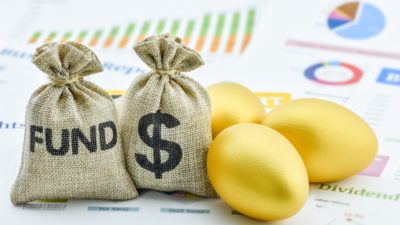By far the biggest advantage of using a Tax-Free Savings Account (TFSA) is the ability to grow your portfolio without incurring a large tax bill along the way. With a registered retirement savings plan, you’re only deferring taxes until when you withdraw the money out from the account. But with a TFSA, that’s not the case. You can always withdraw from the TFSA and not worry about triggering any tax consequences — you just need to be careful not to re-contribute too quickly if you’re near your contribution limit.
Below, I’ll show you how to get a $69,500 TFSA balance to grow to $1,000,000 by investing in a fairly safe investment in Toronto-Dominion Bank (TSX:TD)(NYSE:TD).
How much of an annual return can you expect from TD Bank?
Year to date, shares of TD are down 10% so far. However, 2020 has been an exceptionally unusually year and the year before, and if investors look at the previous 10 years, the stock’s generally been a strong, consistent performer:
Over a 10-year period, shares of TD are up over 120%, averaging out to a compounded annual growth rate (CAGR) of 8.2% during that period.
Using 8.3% seems like a reasonable growth rate, and it could even be higher than that with shares of TD being so low this year. And then let’s not forget its dividend. TD currently pays a quarterly dividend of $0.79, which on an annual basis yields about 4.8%. In five years, the bank’s increased its dividends by 55%, up from $0.51, equating to a compound annual growth rate (CAGR) of 9.1%.
That’s a bit high, and with the economy in a recession and the COVID-19 pandemic to worry about, let’s lower that expectation down to 7% to be a bit conservative as it’s possible TD may stop increasing dividend payments if things get worse or raise its payouts at a slower rate.
So the key assumptions are as follows:
- 8.2% annual growth rate + 4.8% dividend yield
- 7% dividend growth rate
Here’s what the portfolio could look like over the years
| Year | Portfolio | Quarterly Dividend | Annual Dividend | Cumulative Dividend | Portfolio + Dividend |
| 1 | $75,228.90 | $0.79 | $3,327.58 | $3,327.58 | $78,556.48 |
| 2 | $81,430.03 | $0.85 | $3,560.51 | $6,888.08 | $88,318.12 |
| 3 | $88,142.33 | $0.90 | $3,809.74 | $10,697.82 | $98,840.15 |
| 4 | $95,407.92 | $0.97 | $4,076.42 | $14,774.25 | $110,182.17 |
| 5 | $103,272.42 | $1.04 | $4,361.77 | $19,136.02 | $122,408.44 |
| 6 | $111,785.18 | $1.11 | $4,667.10 | $23,803.12 | $135,588.30 |
| 7 | $120,999.66 | $1.19 | $4,993.79 | $28,796.91 | $149,796.57 |
| 8 | $130,973.69 | $1.27 | $5,343.36 | $34,140.27 | $165,113.96 |
| 9 | $141,769.88 | $1.36 | $5,717.39 | $39,857.66 | $181,627.54 |
| 10 | $153,456.00 | $1.45 | $6,117.61 | $45,975.28 | $199,431.28 |
| 11 | $166,105.41 | $1.55 | $6,545.85 | $52,521.12 | $218,626.53 |
| 12 | $179,797.52 | $1.66 | $7,004.05 | $59,525.18 | $239,322.69 |
| 13 | $194,618.26 | $1.78 | $7,494.34 | $67,019.51 | $261,637.78 |
| 14 | $210,660.69 | $1.90 | $8,018.94 | $75,038.46 | $285,699.15 |
| 15 | $228,025.50 | $2.04 | $8,580.27 | $83,618.72 | $311,644.22 |
| 16 | $246,821.69 | $2.18 | $9,180.89 | $92,799.61 | $339,621.30 |
| 17 | $267,167.25 | $2.33 | $9,823.55 | $102,623.16 | $369,790.41 |
| 18 | $289,189.91 | $2.50 | $10,511.20 | $113,134.36 | $402,324.26 |
| 19 | $313,027.89 | $2.67 | $11,246.98 | $124,381.34 | $437,409.23 |
| 20 | $338,830.85 | $2.86 | $12,034.27 | $136,415.61 | $475,246.45 |
| 21 | $366,760.75 | $3.06 | $12,876.67 | $149,292.27 | $516,053.02 |
| 22 | $396,992.92 | $3.27 | $13,778.03 | $163,070.31 | $560,063.22 |
| 23 | $429,717.13 | $3.50 | $14,742.50 | $177,812.81 | $607,529.93 |
| 24 | $465,138.80 | $3.75 | $15,774.47 | $193,587.28 | $658,726.08 |
| 25 | $503,480.29 | $4.01 | $16,878.69 | $210,465.96 | $713,946.26 |
| 26 | $544,982.28 | $4.29 | $18,060.19 | $228,526.16 | $773,508.44 |
| 27 | $589,905.29 | $4.59 | $19,324.41 | $247,850.56 | $837,755.86 |
| 28 | $638,531.31 | $4.91 | $20,677.12 | $268,527.68 | $907,058.99 |
| 29 | $691,165.58 | $5.25 | $22,124.51 | $290,652.19 | $981,817.78 |
| 30 | $748,138.51 | $5.62 | $23,673.23 | $314,325.42 | $1,062,463.93 |
Roughly just over 29 years is what you’d be looking at for your portfolio’s value to grow to over $1 million assuming the above assumptions. Now, this doesn’t mean you should fill your portfolio with shares of TD. Ideally, you’d diversify into other stocks as well. But the point of this is to show that even with a conservative investment like TD, it can generate significant returns over the long term.
Takeaways for investors
Whether you invest in TD, and ETF, or a mix of stocks, the important thing to remember is that it’s going to take time. There’s no quick way to safely grow your portfolio to over $1 million without taking on tremendous risks along the way. It takes a long-term strategy that involves patience.
And by investing in dividend stocks that grow their payouts you can maximize your annual returns and help your portfolio increase at a quick and sustainable rate.
And if you stick to that disciplined approach to investing then you can help set yourself up for a great retirement.










